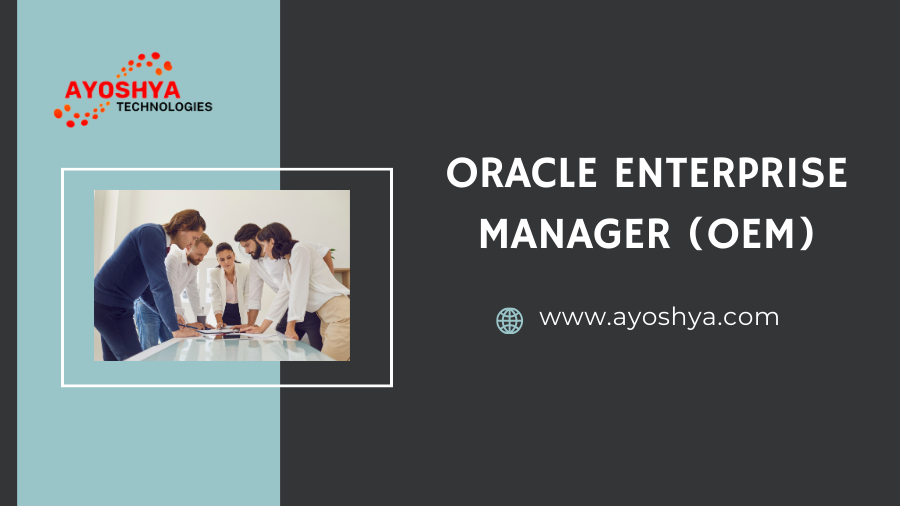Oracle Enterprise Manager (OEM): Elevating Database Management to New Heights
Introduction
In the dynamic landscape of database management, having a robust and centralized tool is paramount. Oracle Enterprise Manager, commonly known as OEM, stands as a beacon for database administrators, offering a comprehensive and integrated solution for managing Oracle environments. This article delves into the intricacies of Oracle Enterprise Manager, exploring its key features, applications, and the transformative impact it has on database administration.
Understanding Oracle Enterprise Manager
Manager is a web-based platform that provides a single, integrated solution for managing Oracle databases, middleware, and applications. It offers a unified interface for monitoring, administration, and performance tuning, making it an indispensable tool for IT professionals.
Key Components
- Database Management: Administer and monitor Oracle databases from a centralized console, streamlining routine tasks.
- Middleware Management: Manage Oracle Fusion Middleware components, ensuring seamless integration and performance.
- Application Management: Gain insights into the performance and health of Oracle applications, enabling proactive issue resolution.
- Cloud Control: Extend management capabilities to Oracle Cloud Infrastructure, facilitating hybrid cloud environments.
Benefits of Oracle Enterprise Manager
- Centralized Management: Manage multiple databases, applications, and middleware instances from a single console.
- Performance Monitoring: Monitor the performance of the entire Oracle stack in real-time, identifying and resolving issues promptly.
- Automation: Automate routine tasks, reducing manual intervention and ensuring consistency in administration.
Real-world Applications
Enterprise Manager finds applications across diverse industries:
- Finance: Ensure the high availability and performance of financial applications and databases.
- Healthcare: Streamline database management for healthcare systems, ensuring data availability and security.
- E-commerce: Optimize the performance of e-commerce applications, improving user experience and reliability.
- Telecommunications: Monitor and manage complex Oracle environments in telecommunications infrastructure.
Integration Capabilities
Enterprise Manager seamlessly integrates with various Oracle technologies, providing a unified management experience. It supports integration with Oracle Cloud Infrastructure, allowing organizations to extend their management capabilities to the cloud.
Usage Scenarios
- Performance Diagnostics:
- Diagnose and resolve performance issues by leveraging advanced diagnostics and tuning features.
- Automated Provisioning:
- Streamline the provisioning of databases and middleware components through automated workflows.
- Security Management:
- Enhance security by monitoring user activities, implementing access controls, and ensuring compliance.
- Backup and Recovery:
- Facilitate efficient backup and recovery operations, ensuring data integrity and availability.
Advanced Functionalities
- Real Application Testing:
- Utilize real application testing features to simulate and analyze changes before applying them to production environments.
- Middleware Diagnostics:
- Diagnose and resolve issues in Oracle Fusion Middleware components, ensuring seamless application integration.
- Custom Monitoring Templates:
- Create custom monitoring templates tailored to specific organizational requirements for proactive issue identification.
Oracle Enterprise Manager vs. Other Management Tools
Compared to standalone management tools, Enterprise Manager offers the advantage of a unified and integrated approach. It provides end-to-end visibility and management capabilities for the entire Oracle technology stack, reducing the complexity of managing multiple tools.
Implementation Best Practices
For optimal utilization of Enterprise Manager:
- Regular Upgrades: Stay current with the latest releases to benefit from new features and enhancements.
- Custom Dashboards: Create custom dashboards to display key performance indicators and metrics relevant to your organization.
- Resource Planning: Adequately plan resources to ensure smooth operation and responsiveness of Enterprise Manager.
Security Measures
- Secure Configuration:
- Ensure a secure configuration of Enterprise Manager, following Oracle’s security best practices.
- Role-based Access Control:
- Implement role-based access controls to restrict user access based on roles and responsibilities.
User Experience and Interface
It provides an intuitive and user-friendly web interface, making it accessible to both seasoned database administrators and IT professionals. The interface allows for efficient navigation and quick access to critical information.
Customization Options
Customization in Oracle Enterprise Manager involves tailoring the interface, creating custom monitoring templates, and defining personalized dashboards. This allows organizations to adapt Enterprise Manager to their specific needs and workflows.
Future Trends and Innovations
As the IT landscape evolves, Enterprise Manager is expected to evolve with it. Anticipated trends include enhanced automation features, increased integration with emerging technologies, and advanced analytics for predictive management.
User Testimonials
Organizations share their experiences with Enterprise Manager, highlighting its role in simplifying database management, improving operational efficiency, and providing a holistic view of their Oracle environments.
Challenges and Solutions
While Oracle Enterprise Manager is a powerful tool, organizations may encounter challenges during implementation. This section addresses common challenges and provides effective solutions to ensure a successful deployment and operation.
Frequently Asked Questions
- Is Oracle Enterprise Manager suitable for small businesses?
- Yes, It is scalable and can be tailored to the needs of small businesses.
- Can they manage non-Oracle databases?
- While primarily designed for Oracle environments, Oracle Enterprise Manager can integrate with some non-Oracle databases for certain management functions.
- What is the role of Oracle Enterprise Manager in cloud environments?
- It extends its management capabilities to Oracle Cloud Infrastructure, allowing organizations to manage on-premises and cloud-based Oracle environments seamlessly.
- Is Oracle Enterprise Manager suitable for hybrid cloud environments?
- Yes, It supports hybrid cloud environments, providing a unified management experience for both on-premises and cloud-based Oracle deployments.
- How often should organizations perform health checks with Oracle Enterprise Manager?
- Regular health checks, ideally scheduled at least quarterly, help ensure the ongoing health and performance of Oracle environments.
Conclusion
In conclusion, Oracle Enterprise Manager emerges as a linchpin in the realm of database management, offering a centralized and integrated solution for Oracle environments. From performance tuning to automation, It empowers organizations to elevate their database management practices to new heights.
You may be interested in:
Oracle Consulting: the Power of Digital Transformation



